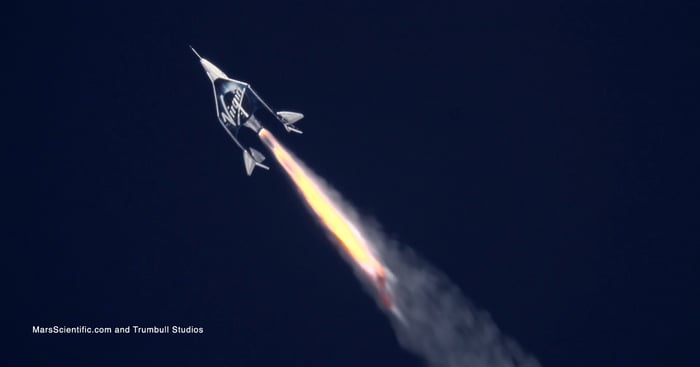Since IPO'ing via a reverse merger into a special purpose acquisition company (SPAC) 10 months ago, space tourism company Virgin Galactic (SPCE -1.09%) has reported quarterly earnings a total of three times. The first time, it reported a $73 million net loss on barely a half million dollars in revenue. The second time it reported a $60 million loss on half as much revenue.
Last quarter, Virgin Galactic lost more than $62 million -- on no revenue at all.

Image source: Virgin Galactic.
Promises, promises
The whole time, Virgin Galactic has been assuring investors that it would begin sending customers to space in 2020, and book its first profit in 2021. But in that last, revenue-less quarterly report, Virgin Galactic finally admitted that commercial operations will actually have to be pushed back into 2021 -- meaning profits might be pushed back even further.
And yet, Virgin Galactic must still hope to earn a profit eventually. So how does it plan to make that happen? Last week the company gave us a clue.
Inside information -- now available on Twitter
More precisely, Virgin Galactic gave stock analysts at Jefferies & Co. a clue, conducting a conference call with the investment bank which was promptly recapped by CNBC space-beat reporter Michael Sheetz on Twitter:
After a call with Virgin Galactic $SPCE executives, Jefferies says the second SpaceShipTwo spacecraft is on track to roll out by the end of 2020.
-- Michael Sheetz (@thesheetztweetz) September 16, 2020
–Cost to produce more spacecraft targeted $30M-$35M per vehicle
–Each built to last 10+ years and fly 50 flights per year pic.twitter.com/fqB2TFmSyu
Let's break down that tweet. According to Virgin's execs, although it has yet to fly a single commercial flight with its first "SpaceShipTwo" (SS2) spaceplane, Virgin is already looking ahead to the day when it has proven its spaceplane safe to fly on, begun flying commercially, and generated so much demand that it needs to start flying a second plane.
Construction costs per spaceplane are approximately $30 million to $35 million, and each spaceplane is built to carry a total of six paying passengers in addition to a flight crew of two. At an estimated ticket cost of $250,000 per seat, therefore, Virgin Galactic can expect to record approximately $1.5 million in revenue per flight. Thus, leaving aside overhead costs, it's reasonable to assume that Virgin Galactic can pay for the construction of each incremental spaceplane after about 20 flights.
So assuming Virgin Galactic achieves its stated goal of flying 50 times per year, that's about seven months' revenue that will be required to pay for each spaceplane. If each spaceplane has a service life of "10+ years," there should be plenty of time for each one to earn its keep -- and generate profits for the company.
Caveats and provisos
There is one caveat to the math above, however -- that overhead cost I mentioned up above. You see, in a subsequent tweet, Sheetz noted that each SS2 flight incurs a significant one-time cost -- in the form of replacing its engine!
Jefferies also noted that the largest cost for each flight is the second-generation RocketMotorTwo engine, which costs between $250k-$275k to replace each flight – but Virgin Galactic expects that cost to come down as the flight cadence increases.
-- Michael Sheetz (@thesheetztweetz) September 16, 2020
And I have to say, this seems to have come as something of a shock to Twitter readers who noticed this addendum. "They are replacing engine EACH flight?" responded one inquiring mind.
That's an understandable reaction, inasmuch as the stated engine cost -- $250,000 to $275,000 -- will eat up all the revenue from one ticket-seat per flight, subtract one-sixth from Virgin Galactic's gross profit, and add another month to the time it will take any given SS2 to pay for its own construction cost.
Why is this?
Turns out, unlike "ordinary" airplanes that don't fly to space, SpaceShipTwo is powered by a novel "RocketMotorTwo" -- a hybrid solid fuel engine that burns a plastic "hydroxyl-terminated polybutadiene" (HTPB) fuel cartridge to propel the spaceplane into space. This means that preparing the SS2 for a repeat flight is not a simple matter of "putting more gas in the tank." After each use, the HTPB fuel cartridge needs to be replaced -- which is sort of like replacing the engine after each flight.
What it means to investors
Suffice it to say that this sounds like an inefficient way to run an airline, even one as unique as Virgin Galactic. Still, it won't utterly prevent the company from turning a profit, just postpone the breakeven point a bit. For the time being, Virgin Galactic is probably best advised to leave optimizing the operating costs of its SS2 spaceplane for a later date, and focus instead on just getting its final test flights out of the way, its CEO's first trip accomplished, and commercial operations begun.
The next step to doing that: Virgin Galactic will conduct a crewed spaceflight test less than a month from now, on Oct. 22.





